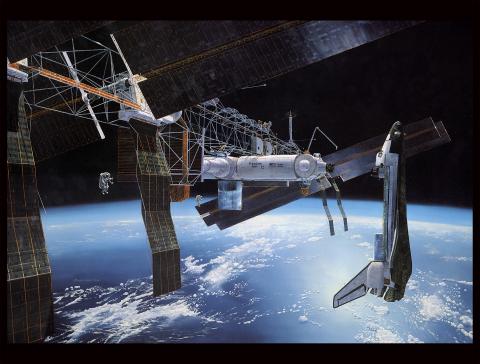

illustration and soon transitioned into technical illustration and drafting. After working for a variety of engineering firms, Eaton became a freelance artist. Eventually he went to work for Thiokol where his artistic talents documented the Space Shuttle Program as well as other space and military projects. The artist states, “These experiences fulfilled a lifelong dream.”
Included in the exhibit is Eaton’s “Challenge Traditions,” a montage of significant transportation events throughout history. Utah’s connection is illustrated by a space shuttle rising above two trains facing each other when the ceremonial “golden spike” was driven at Promontory Summit connecting the first transcontinental railroad in 1869.
The history of Thiokol is as fascinating as spaceflight. In 1926, two chemists, Joseph C. Patrick and Nathan Mnookin, were trying to invent an inexpensive antifreeze. While experimenting with ethylene dichloride and sodium polysulfide, they created a gum that emitted a terrible odor and clogged a sink in the laboratory. None of their solvents could remove the gum. The frustrated chemists then realized that the resistance of the material to any kind of solvent was a useful property. They had invented a synthetic rubber, which they christened “Thiokol,” a combination of the Greek words for sulfur and glue.
Thiokol Corporation was formed in 1928 to commercialize the new product. The company’s future changed forever in 1945 when scientists discovered that the polymer made the best solid propellant fuel binder known to man. In 1947, Thiokol entered the solid rocket motor market.
***Article written by Mary Alice Hobbs
Captions for photos:
Artist Mark Waki, painting T-Plus 30, Orbital ATK exhibit
“Thundering Aloft” by Mark Waki, Orbital ATK Exhibit
“Space Station Freedom” by Mark Waki, Orbital ATK Exhibit